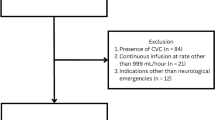Summary
The effects of minimally invasive surgery on the blood-brain barrier (BBB) of 30 patients with cerebral hemorrhage were investigated. Difference of the BBB index and serum MBP concentration were assessed in 15 cases of conservative treatment group and 15 cases of minimally invasive surgery group. The BBB index in minimally invasive surgery group was significantly lower than in conservative treatment group (P<0.05), and the BBB index in the two treatment groups was significantly higher than in control group (P<0.01). Serum MBP concentration in minimally invasive surgery group was significantly lower than in conservative treatment group (P<0.05), and that in the two treatment groups was significantly higher than in control group (P<0.01). It was suggested the permeability of BBB in patients with cerebral hemorrhage was increased, and BBB index and serum MBP concentration in patients with cerebral hemorrhage were increased. Minimally invasive surgery can reduce the lesion of cytotoxicity to BBB and cerebral edema.
Similar content being viewed by others
References
Xi G, Keep R F, Hua Y et al. Mechanisms of edema formation following intracerebral hemorrhage: does hemolysate cause ischemia in intracerebral hemorrhage? J Neurosurg, 2001,94(1):162–163
Song T, Hu X P, Zhang J L T et al. Analysis of prognosis factors in minimally invasive puncture and drainage of intracranial hematoma with hypertension. J Clin Gathering (Chinese), 2000, 15(3):75–76
Chen J J, Wang R H, Li C L et al. Simplified enzyme-linked immunoadsorbent assays for myelin basic protein and antibodies to myelin basic protein. J Huaxi Med Univ (Chinese), 1995,18(5):304–305
Nadagawa H, Yamada M, Kanayama T et al. Myelin basic protein in the cerebrospinal fluid of patients with brain tumors. J Neurosurg, 1994,34:727–825
Maeshima S, Funahashi K, Ogura M et al. Unilateral spatial neglect due to right frontal lobe haematoma. J Neurol Neurosurg Psychiatry, 1994,57:89–93
Matsushital K, Meng W, Wang X et al. Evidence for apoptosis after intercerebral hemorrhage in rats striatum. J Cereb Blood Flow Metab, 2000,20(2):396–404
Gong C, Boulis N, Qian J et al. Intracerebral hemorrhage-induced neuronal death. Neurosurgery, 2001,48(4):875–883
Demichele M A, Minnear F L. Modulation of vascular endothelial permeability by thrombin. Semin Thromb Hemostasis, 1992,18:287
Author information
Authors and Affiliations
Additional information
HUANG Xiaojiang, female, born in 1978, Resident Doctor, Doctorial Candidate
Rights and permissions
About this article
Cite this article
Huang, X., Guo, S. & Wang, W. Effects of minimally invasive puncture and drainage of intracranial hematoma on the blood-brain barrier in patients with cerebral hemorrhage. J. Huazhong Univ. Sc. Technol. 27, 101–103 (2007). https://doi.org/10.1007/s11596-007-0128-8
Received:
Issue Date:
DOI: https://doi.org/10.1007/s11596-007-0128-8




